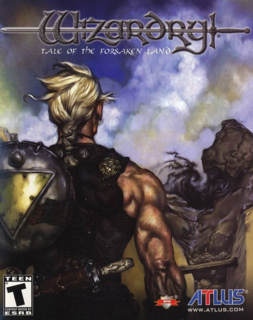Atlus offers a completely different take on the classic PC RPG series
In the graphics department, the game is extremly good for a early-gen PS2 title. While the NPC and the original characters that join your party look like still images, they show the vastly done artwork that makes this game unqiue. When you get into the dungeon, which the game officially calls the "Labrynith", the game makes the most out of the rarely-use CD-ROM format that the PS2 uses beside the standard DVD-ROM Format. Also, the monsters that you fight are very detailed and high resolution, with each monster type having different poses for different actions, such as the bubbly slime turning into stone and the Bushwacker defending.
Soundwise, the game is excellent, if not lacking, It has many different sound effects, such as swords clanging, the dragons roaring in battle and the sounds of people talking in the tavern. While most RPGs, even as early as the PSOne era, boast huge musical soundtracks, Wizardry: Tale of the Forsaken Land, keeps it's soundtrack simple by only having about 7-9 songs. Also, the battle theme changes as you delve deeper into the Labrynith, which keeps the game completely fresh.
Regarding controls, it's what you would expect from a Wizardry title, and then some. While you have your basic controls to go through menus, walk in the dungeons and select battle commands, you also have an abiltiy that usually seen in FPSs and not old school dungeon crawls--The abilty to strafe either left or right. This control allows you to prevent your party from getting ambushed from behind very often. Another interesting control quirk is the abilty to look at your surroundings by using the right analog stick. It will give you a good sense of where you're currently at.
As far as gameplay is concerned, it's excellent, with a couple flaws. While the actual dungeon is only 10-11 floors deep, the game gets replayability in the form of quests. You go to the tavern and accept one of them, go to the Labrynith and find the quest objective (which usually involve finding a key item) and go back to the tavern to claim your reward in experience and gold. On an interesting note, the game has a ton of nasty traps, most of which can be avoided by pressing the buttons in the order as shown on-screen.
While the gameplay is good, it isn't without it's flaws. For example, if one of your PCs gets killed, you have the chance of reviving him/her. If it fails, then the PC is turned into ashes. If the resurrection attempt to return the PC from ashes fails, the PC is permanenty removed from the character roster. That can get quite annoying for those who are familiar with RPGs such as Final Fantasy VII. Another flaw is that getting the neccessary materials to make magic stones to learn and level-up spells takes an extremely long time, especially when most sources of said materials come from treasure dropped by monsters.
Overall, Wizardry: Tale of the Forsaken Land is a highly addicting RPG and is a must get for all fans of role-playing games, whether they be Japanese, Western or the pen-and-paper variety. To miss out on this RPG would be a deadly sin.

